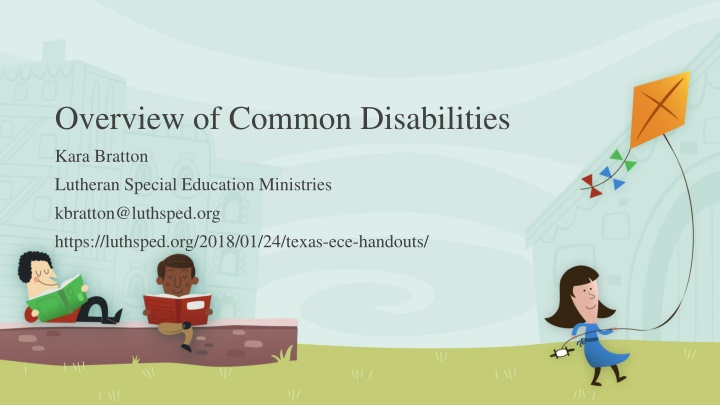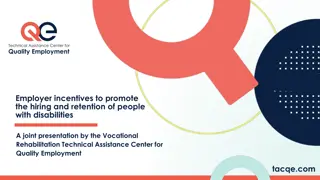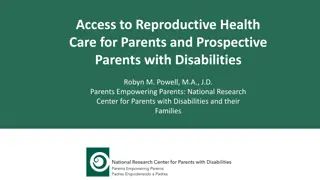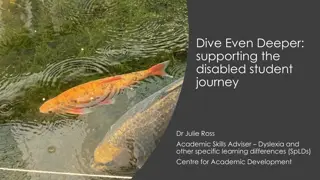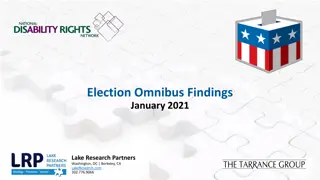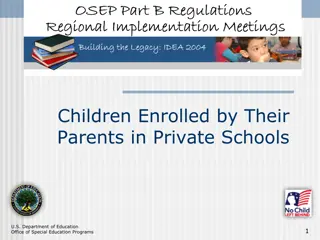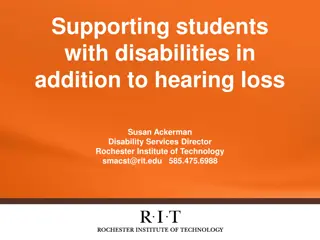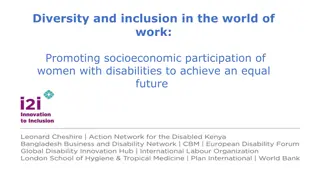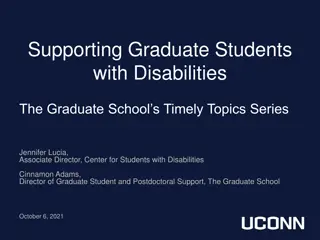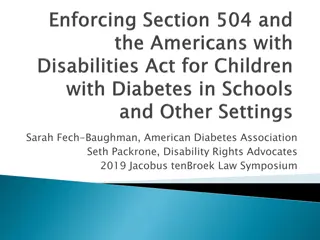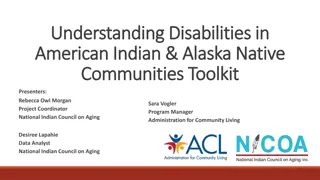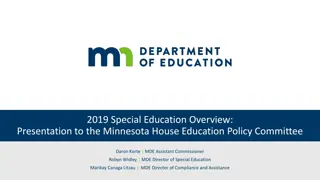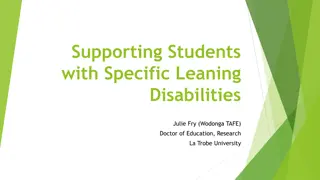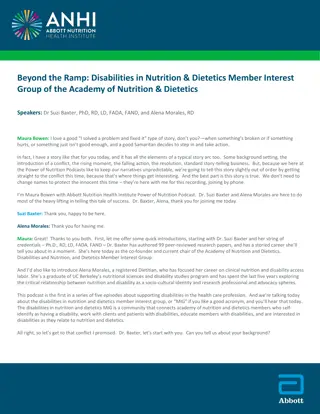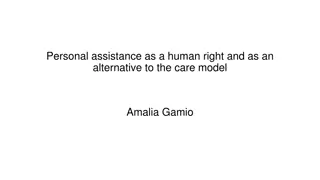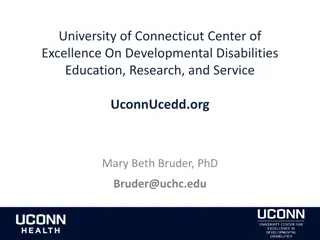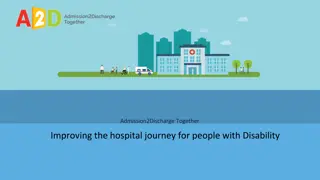Common Disabilities Overview
This content provides valuable insights into common disabilities, including a focus on autism spectrum disorder early signs. It also includes reading and writing simulations for better understanding. Explore the characteristics and symptoms of autism, along with helpful resources for evaluation.
Download Presentation

Please find below an Image/Link to download the presentation.
The content on the website is provided AS IS for your information and personal use only. It may not be sold, licensed, or shared on other websites without obtaining consent from the author.If you encounter any issues during the download, it is possible that the publisher has removed the file from their server.
You are allowed to download the files provided on this website for personal or commercial use, subject to the condition that they are used lawfully. All files are the property of their respective owners.
The content on the website is provided AS IS for your information and personal use only. It may not be sold, licensed, or shared on other websites without obtaining consent from the author.
E N D
Presentation Transcript
Overview of Common Disabilities Kara Bratton Lutheran Special Education Ministries kbratton@luthsped.org https://luthsped.org/2018/01/24/texas-ece-handouts/
Reading Simulation When you see: Pronounce as: q d or t z m p b b p ys er a, as in bat e, as in pet e, as in pet a, as in bat http://www.pbs.org/wgbh/misunderstoodminds/experiences/readexp1a.html
Reading Simulation Passage: We pegin our qrib eq a faziliar blace, a poqy like yours enq zine. Iq conqains a hunqraq qrillion calls qheq work qogaqhys py qasign. Enq wiqhin each one of qhese zany calls, each one qheq hes QNA, Qhe QNA coqe is axecqly qhe saze, a zess-broquceq rasuze. So qhe coqe in each call is iqanqical, a razarkaple puq veliq claiz. Qhis zeans qheq qhe calls are nearly alike, puq noq axecqly qhe saze. Qake, for insqence, qhe calls of qhe inqasqines; qheq qhey're viqal is cysqainly blain. Now qhink apouq qhe way you woulq qhink if qhose calls wyse qhe calls in your prain.
Reading Simulation Here is the translation: We begin our trip at a familiar place, a body like yours and mine. It contains a hundred trillion cells that work together by design. And within each one of these many cells, each one that has DNA, The DNA code is exactly the same, a mass-produced resume. So the code in each cell is identical, a remarkable but valid claim. This means that the cells are nearly alike, but not exactly the same. Take, for instance, the cells of the intestines; that they're vital is certainly plain. Now think about the way you would think if those cells were the cells in your brain. (Excerpt from "Journey into DNA" on the "Cracking the Code" Web site, NOVA Online.)
Reading and Writing Simulation Reading Simulation https://www.understood.org/en/tools/through-your-childs- eyes/player?simq=c07181bd-05a5-466c-aaa0- f54146a9d844&standalone=true&simulation=true Writing Simulation https://www.understood.org/en/tools/through-your-childs- eyes/player?simq=a06af01c-0a60-45c0-b306- 2e8714d05bb4&standalone=true&simulation=true
Autism: Early Signs The characteristic behaviors of autism spectrum disorder may be apparent in infancy (18 to 24 months), but they usually become clearer during early childhood (24 months to 6 years) Most obvious signs of autism and symptoms of autism tend to emerge between 2 and 3 years of age Any of these red flags does not mean a child has autism. But because the disorder s symptoms vary so widely, a child showing these behaviors should be evaluated by a multidisciplinary team Under the DSM-5 criteria, individuals with ASD must show symptoms from early childhood, even if those symptoms are not recognized until later
Autism: Early Signs No big smiles or other warm, joyful expressions by six months or thereafter No back-and-forth sharing of sounds, smiles, or other facial expressions by nine months or thereafter No babbling by 12 months No gesturing (pointing, waving bye-bye) by 12 months No words by 16 months No two-word meaningful phrases (without imitating or repeating) by 24 months Any loss of speech or babbling or social skills at any age
Autism: Early Signs Doesn t make eye contact (e.g. look at you when being fed). Doesn t smile when smiled at. Doesn t respond to his or her name or to the sound of a familiar voice. Doesn t follow objects visually. Doesn t point or wave goodbye or use other gestures to communicate. Doesn t follow the gesture when you point things out.
Autism: Early Signs Doesn t make noises to get your attention. Doesn t initiate or respond to cuddling. Doesn t imitate your movements and facial expressions. Doesn t reach out to be picked up. Doesn t play with other people or share interest and enjoyment. Doesn t ask for help or make other basic requests.
Learning Disabilities: Signs Preschool Speaks later than most children Pronunciation problems Slow vocabulary growth, often unable to find the right word Difficulty rhyming words Trouble learning numbers, alphabet, days of the week, colors, shapes Extremely restless and easily distracted Trouble interacting with peers Difficulty following directions or routines Fine motor skills slow to develop
Learning Disabilities: Signs Grades K-4 Slow to learn the connection between letters and sounds Confuses basic words (run, eat, want) Makes consistent reading and spelling errors including letter reversals (b/d), inversions (m/w), transpositions (felt/left), and substitutions (house/home) Transposes number sequences and confuses arithmetic signs (+, -, x, /, =) Slow to remember facts Slow to learn new skills, relies heavily on memorization Impulsive, difficulty planning Unstable pencil grip Trouble learning about time Poor coordination, unaware of physical surroundings, prone to accidents
Reading Resources http://www.fcrr.org/for-educators/sca.asp http://www.pbs.org/launchingreaders/ http://www.readtheory.org Starfall: http://more.starfall.com/m/welcome/index/load.htm Get Ready to Read Games: http://www.getreadytoread.org/skill-building-activities/online-games Skill Building Activities: http://www.getreadytoread.org/skill-building-activities
Signs of Math Difficulties Warning Signs in Preschool or Kindergarten Has trouble learning to count, especially when it comes to assigning each object in a group a number Has trouble recognizing number symbols, such as making the connection between 7 and the word seven Struggles to connect a number to a real-life situation, such as knowing that 3 can apply to any group that has three things in it 3 cookies, 3 cars, 3 kids, etc. Has trouble remembering numbers, and skips numbers long after kids the same age can count numbers and remember them in the right order Finds it hard to recognize patterns and sort items by size, shape or color Avoids playing popular games like Candy Land that involve numbers, counting and other math concepts
Signs of Math Difficulties Warning Signs in Grade School Has trouble recognizing numbers and symbols Has difficulty learning and recalling basic math facts, such as 2 + 4 = 6 Struggles to identify +, and other signs and use them correctly May still use fingers to count instead of using more sophisticated strategies Has trouble writing numerals clearly or putting them in the correct column
Math Strategies http://illuminations.nctm.org/Default.aspx http://illuminations.nctm.org/unit.aspx?id=6136 http://illuminations.nctm.org/Activity.aspx?id=3564 (online game) http://www.nctm.org/Classroom-Resources/ARCs/Counting-Strategies/ http://www.nctm.org/Classroom-Resources/ARCs/Building-Fluency-Using-Combinations-of- 10/ http://earlylearningfoundation.com/publications/ Math Moms and Dads program http://www.doe.virginia.gov/instruction/mathematics/elementary/number_sense_module/nn s_modules_2012.pdf
Indicators of ADD/ADHD Some signs of hyperactivity-impulsivity are: Feeling restless, often fidgeting with hands or feet, or squirming while seated Running, climbing, or leaving a seat in situations where sitting or quiet behavior is expected Blurting out answers before hearing the whole question Having difficulty waiting in line or taking turns Difficulty engaging in activities quietly Acts as if driven by a motor Interrupts; talks excessively
Indicators of ADD/ADHD Some signs of inattention: Difficulty sustaining attention Does not appear to listen Struggles to follow through; forgetful Often becoming easily distracted by irrelevant sights and sounds Often failing to pay attention to details and making careless mistakes Rarely following instructions carefully and completely losing or forgetting things like toys, or pencils, books, and tools needed for a task Often skipping from one uncompleted activity to another
Indicators of ADD/ADHD Questions to consider: Is the behavior of the child similar to the behavior of other children the same age? Is the behavior developmentally appropriate for the child s age? Is there a pattern of behavior as the child engages in activities? Is there a pattern of behavior across settings?
Indicators of ADD/ADHD Because everyone shows some of these behaviors at times, the diagnosis requires that such behavior be demonstrated to a degree that is inappropriate for the person's age. The diagnostic guidelines also contain specific requirements for determining when the symptoms indicate ADHD. The behaviors must appear early in life, before age 7, and continue for at least 6 months. Above all, the behaviors must create a real handicap in at least two areas of a person's life such as in the schoolroom, on the playground, at home, in the community, or in social settings. So someone who shows some symptoms but whose schoolwork or friendships are not impaired by these behaviors would not be diagnosed with ADHD. Nor would a child who seems overly active on the playground but functions well elsewhere receive an ADHD diagnosis. To assess whether a child has ADHD, specialists consider several critical questions: Are these behaviors excessive, long-term, and pervasive? That is, do they occur more often than in other children the same age? Are they a continuous problem, not just a response to a temporary situation? Do the behaviors occur in several settings or only in one specific place like the playground or in the schoolroom? The person's pattern of behavior is compared against a set of criteria and characteristics of the disorder as listed in the Diagnostic and Statistical Manual of Mental Disorders (DSM-IV-TR.) ldonline.org
Risk Indicators for Preschoolers A history of significant language delay or disorder, even if the child currently appears to have age- appropriate language abilities Limited exposure to oral and written language before beginning school A native language other than English A disability that affects oral language acquisition, such as a hearing impairment A significant history of reading difficulties in close family members Oral language difficulties (poor vocabulary, listening comprehension, or grammatical abilities for the child s age)
Risk Indicators for Children in Kindergarten and First Grade Poor phonological/phonemic awareness (inability to rhyme, identify initial and final sounds of spoken words, or to blend and segment one-syllable spoken words) Lack of familiarity with basic print concepts such as (1) print conveys meaning, (2) print is read left to right, and (3) words are separated by spaces Poor knowledge of common letter-sound relationships Difficulty decoding unfamiliar words at the middle or end of first grade, especially as measured by reading of nonsense words such as zat
Risk Indicators for Children in Second and Third Grade Ongoing difficulties with decoding of unfamiliar words Slow, labored, dysfluent reading in grade- appropriate text Poor reading comprehension Poor spelling
Explicit Teaching Incidental Learning vs. Explicit Teaching Incidental Learning: Teachers creating opportunities for children to learn through experience and natural interactions Explicit Teaching: Teachers provide direct, specific instruction Children may benefit from both, but struggling learners typically need more explicit instruction
Working Memory Working memory difficulties common in students with learning disabilities and ADHD Working memory is the ability to hold AND manipulate information over short periods of time
Working Memory Average adults can only hold 6-7 units of information in working memory (units may be comprised of individual elements grouped together) Typical 4 year olds may hold 2 units of information in working memory Typical 15 years old may hold 4-5 units of information in working memory
Working Memory Strategies Minimize background noise involving language Rehearse contents of working memory for retention Use visuals and memory aids but also teach students where to locate information and how to use Reduce working memory loads and repeat important information Once information is lost from working memory, it s GONE and can not be recovered Resource: Working Memory & Learning: A Practical Guide for Teachers by Susan E. Gathercole & Tracy Packiam Alloway
IDEA Categories of Disability (each state may have its own criteria for qualification) Specific Learning Disability Hearing Impairment Other Health Impairment Deaf-Blindness Autism Spectrum Disorder (ASD) Orthopedic Impairment Emotional Disturbance Intellectual Disability Speech or Language Impairment Traumatic Brain Injury Visual Impairment, including Blindness Multiple Disabilities Developmental Delay Deafness
Qualifying under IDEA To qualify as a child with a disability, and be eligible for special education, a child s educational performance must be adversely affected due to the disability Having a disability does not necessarily make a child eligible for special education. IDEA regulations state: Child with a disability means a child evaluated in accordance with 300.304 through 300.311 as having [one of the disabilities listed above] and who, by reason thereof, needs special education and related services. This means that, because of the disability, the child needs special education and related services. Many children have disabilities that do not bring with them the need for extra educational assistance or individualized educational programming. http://www.parentcenterhub.org/categories/
Child Find for Birth-Preschool From infancy until age 3, children can receive help through early intervention services. The IDEA requires that every state provide early intervention without a referral. A free evaluation is available from the state s early intervention services program. If the child is found to have a disability or serious developmental delay, services such as speech therapy or occupational therapy will be provided in the home, at no cost to the family. If the child qualifies for these services, the family will work with a team of educators to develop an Individualized Family Service Plan (IFSP) for the child. The IFSP is legally binding and specifies what services and supports will be provided to the child.
Child Find for Birth-Preschool IDEA guarantees that eligible preschoolers, ages 3 to 5, can get an Individualized Education Program (IEP) and special education services through the public school system. This is also a legally binding document and spells out the services and accommodations the school district will provide to meet the child s needs. If the child qualifies for an IEP, he or she will most likely be offered a free spot at a preschool run by the district.
Child Find for Birth-Preschool Here s how to try to get an IEP for a child between the ages of 3 and 5: Look, listen and list concerns. Observe and keep a list of behaviors or other examples that lead to the thought of a learning or attention difficulty. Talk to the parents. Share observations and concerns with the child s parents. Ask if they see the same things at home or if they ve addressed concerns with a pediatrician. Get a referral for an evaluation. If the parents share your concerns, ask for a referral to your state s Child Find program or ask parents to make the contact (depending on district procedures). Parents can also send a letter requesting an evaluation to the district s special education department.
Child Find for Birth-Preschool The request for an evaluation can be denied After a complete evaluation, the child will qualify for an IEP if he or she meets these criteria: At least 3 years old. The evaluation shows a disability or delay covered by IDEA. Need for special education services to address those issues before starting kindergarten.
Process for Evaluation Think about the purpose of possible evaluation Young children, while eligible for Child Find, are often difficult to assess or for assessment to show information needed for diagnosis Assessment results are a major determinant of eligibility so age does need to be considered depending on the potential diagnosis What information does the teacher/school need in order to help the child? Are interventions and supports currently helping the child succeed? What information could be added from an evaluation that would change instruction?
Process for Evaluation Meet with parents when you have concerns Discuss if the difficulties are new or recurring. Parents can share information from previous years and home observations Is the difficulty constant or isolated? Teacher can document difficulties that are not isolated with dates Is the difficulty appropriate for children of this age or is it an atypical difficulty Develop a plan based on meeting Keep parents informed about any changes and progress If determined interventions are not producing improvement, moving on to a referral or pre-referral (depending on district procedures) may be helpful
What To Look For Risk Indicators Response to Accommodations and Interventions Behaviors Parental Input Observe and document all of these!
Documentation Sample forms for intervention progress and meeting documentation (see forms on website link) DIBELS PELI for Early Childhood https://dibels.org/peli.html CDC Milestone Tracker- https://www.cdc.gov/ncbddd/actearly/milestones-app.html Ages and Stages Questionnaire FREE online screening tool from Easter Seals for children birth through age 5 https://www.asqonline.com/family/993-screening-family-access-open-asq-3-english/start Essential Skills Inventory from Bob Sornson http://earlylearningfoundation.com/publications/ Preschool essential skills also available from website link at beginning of presentation
Parent Resources CDC Milestone Moments https://www.cdc.gov/ncbddd/actearly/pdf/parents_pdfs/MilestoneMomentsEng508.p df https://www.cdc.gov/ncbddd/actearly/pdf/checklists/all_checklists.pdf CDC How to Help Your Child and How to Talk with the Doctor https://www.cdc.gov/ncbddd/actearly/pdf/parents_pdfs/CDC_LTSAE-Concerned- about-Development_Eng.pdf Tips for Talking with Parents about Developmental Concerns https://www.cdc.gov/ncbddd/actearly/pdf/parents_pdfs/TipsTalkingParents.pdf
Parent Resources Autism Speaks Resources https://www.youtube.com/watch?time_continue=7&v=xaWUsXk4nD8 Talking to Parents about Autism Kit https://www.autismspeaks.org/what-autism/learn-signs/talking-parents- about-autism-action-kit Understood.org
Talking to Parents Talk with parents regularly about the child, not only when you notice a difficulty Start with the child s strengths Have documentation ready, and copies available for parents Discuss behaviors/academic concerns you see in the classroom Listen to their concerns and observations Do not make or suggest a diagnosis yourself Encourage the parent to talk to appropriate doctor for evaluation Follow up after a few weeks https://www.cdc.gov/ncbddd/actearly/pdf/parents_pdfs/TipsTalkingParents.pdf
Talking to Parents When parents disagree Avoid becoming defensive, but state that you are describing and documenting what you see; ask parent how this seems different from what they see at home When parents become upset or angry Reinforce the idea that you are trying to help their child as best as you possibly can Ask if they would like to think about what you said on their own and meet again at a different time If you believe meeting or followup may be contentious, ask a director or other teacher to attend the meeting as well
Tools ADDES 4 (Attention Deficit Disorder Evaluation Scale-4th Edition)- https://www.hawthorne-ed.com/pages/adhd/ad1.html ADD/ADHD Online Screen: https://www.additudemag.com/adhd-symptoms- test-children/?src=embed_link Modified Checklist for Autism in Toddlers (M-CHAT-R)- https://www.autismspeaks.org/what-autism/diagnosis/screen-your-child Get Ready to Read Screening Tool- http://www.getreadytoread.org/screening-tools/grtr-screening-tool/the-tool
Tools Early Learning Observation and Rating Scale (puts focus on signs of learning disabilities)- http://www.getreadytoread.org/screening-tools/early-learning-observation-rating-scale/elors-the- observation-forms Getting Ready for Kindergarten Parent Checklists http://www.getreadytoread.org/images/content/downloads/Kindergarten_Readiness_Toolkit/Handout s/getting_ready_for_kindergarten_handouts.pdf Teacher Checklists http://www.getreadytoread.org/images/content/downloads/Kindergarten_Readiness_Toolkit/03_kinde rgarten_readiness_checklist.pdf http://www.getreadytoread.org/images/content/downloads/Kindergarten_Readiness_Toolkit/04_readi ness_indicators_observation_guide.pdf
Stay in Touch! Luthsped.org Sign up for our free e-newsletters Always available for FREE consultations Available for professional development for schools and churches
